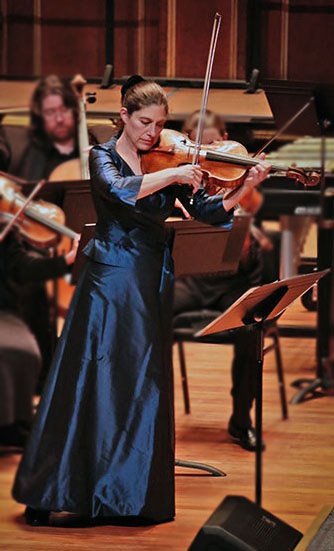Violist, Conductor and Band All Byronic

Perhaps the rarity of Berlioz’s Harold in Italy on the concert stage is due to the misperception that violists don’t make compelling soloists. All the more reason to get to Jordan Hall Saturday or Sanders Theater Sunday to hear Kim Kashkashian play the hell out of it with the Boston Philharmonic, in a perfect marriage of piece, soloist, ensemble and conductor. Benjamin Zander banished the dust, dullness, and sluggish tempos of middling performances, revealing the musical equivalent of a freshly cleaned Sistine Chapel. This successor to Symphonie Fantastique possesses all the drama, storytelling, and rich orchestral color that mark that far more famous work.
Zander told us how in 1834, Berlioz was approached by Paganini to commission a concerto to show off his brand-new Stradivarius viola. Berlioz happily accepted and wrote an unusual work in which the viola is both part of and a commentator on the orchestral action. This is not a concerto in in which the soloist shows off his chops, and the orchestra answers and supports. The melody of the viola is woven into the sonic fabric in a new way, as Berlioz described it, reminiscent of Byron’s Childe Harold, on a trip to Italy. In long stretches of the work, the viola is either silent, or indistinguishable in the orchestral textures; in moments when the instrument shines out, sometimes Berlioz reinforces its sound with doubling from the French horn, cornet, or all four bassoons—a brilliant technique in pre-amplification days! Paganini hated the piece and never performed it, nor did he pay the promised commission, and Harold in Italy premiered disastrously with another violist. William Primrose and the Boston Symphony made the first-ever-recording in 1944.
During the long orchestral introduction before the violist enters with the Harold theme, Kashkashian stayed in back, then she gave her opening duet next to (and with) the harp before slowly making her way forward. I’ve only ever this brilliant choreography before written into the opening of Gunther Schuller’s Viola Concerto, where the viola soloist starts in the wings and then enters playing. She reversed this procedure at the conclusion.
Kashkashian’s gorgeous amber tone and wide range of dynamics and emotion proved the viola as expressive as any other solo instrument and then some. She is agile on stage; at many times the viola rose to meet the bow, as the bow drew the sound from above. Normally the viola or violin on the left arm is more passive, and the sound is drawn from the bow in the right hand alone. Kashkashian uses BOTH arms equally, which may be unique to her. It was eye opening in terms of a new way to produce sound, articulation, and color. Her viola has a narrower upper body and a very broad lower bout, which also gives it huge power when summoned. Zander chose tempi that are far brisker than standard, but never felt rushed.
The Boston Philharmonic may resemble a luxury liner with 32 violins, 12 violas, and 12 celli, and 7 basses, and in the room developed a satisfying timbral richness, but responding to Zander, it also has the turning radius of a Ferrari.
Among the outstanding orchestral solo moments throughout, the tambourine shakers should get a special shoutout for their punch. The violin sections, indeed all the string sections, from front to back stands achieve an outstanding unity. The horn sections punched at Wagnerian weight when called upon, and the brass were appropriately bright and menacing. Berlioz surely knows how to write for trombone. Within the splendid winds, kudos to English hornist Peggy Pearson.
After intermission, the orchestra gave a polished reading of Jean Sibelius’s Second Symphony. Zander told of how Sibelius stitched together fragments, and indeed the composer has imagined re-setting mosaic tiles that have fallen from of heaven. How long stretches of repeated notes in unison can make for drama and beauty is a mystery, but the ministrations of Sibelius, Zander and the BPO summoned brilliant Finnish sunlight, jagged mountain peaks, and rushing streams, in a vision of the grandeur of nature even without resort to any programmatic instructions.
This concert was nothing short of magnificent.
 Elisa Birdseye - The Boston Musical Intelligencer
Elisa Birdseye - The Boston Musical Intelligencer